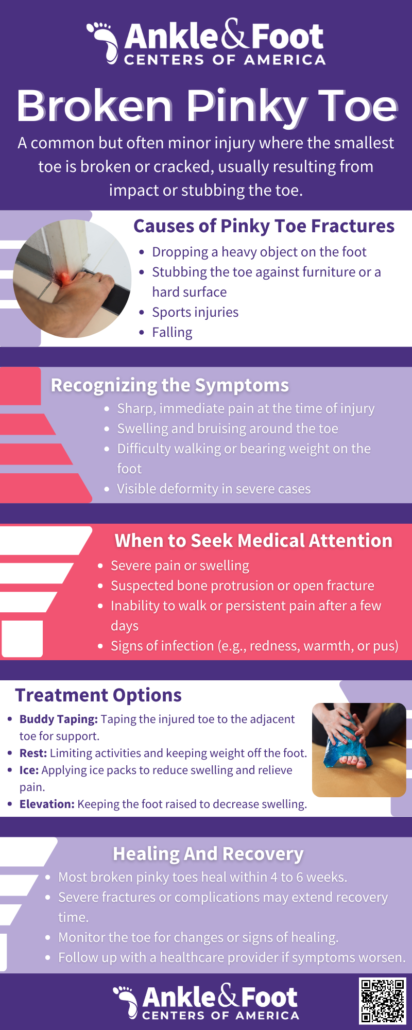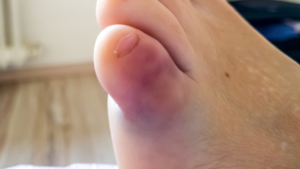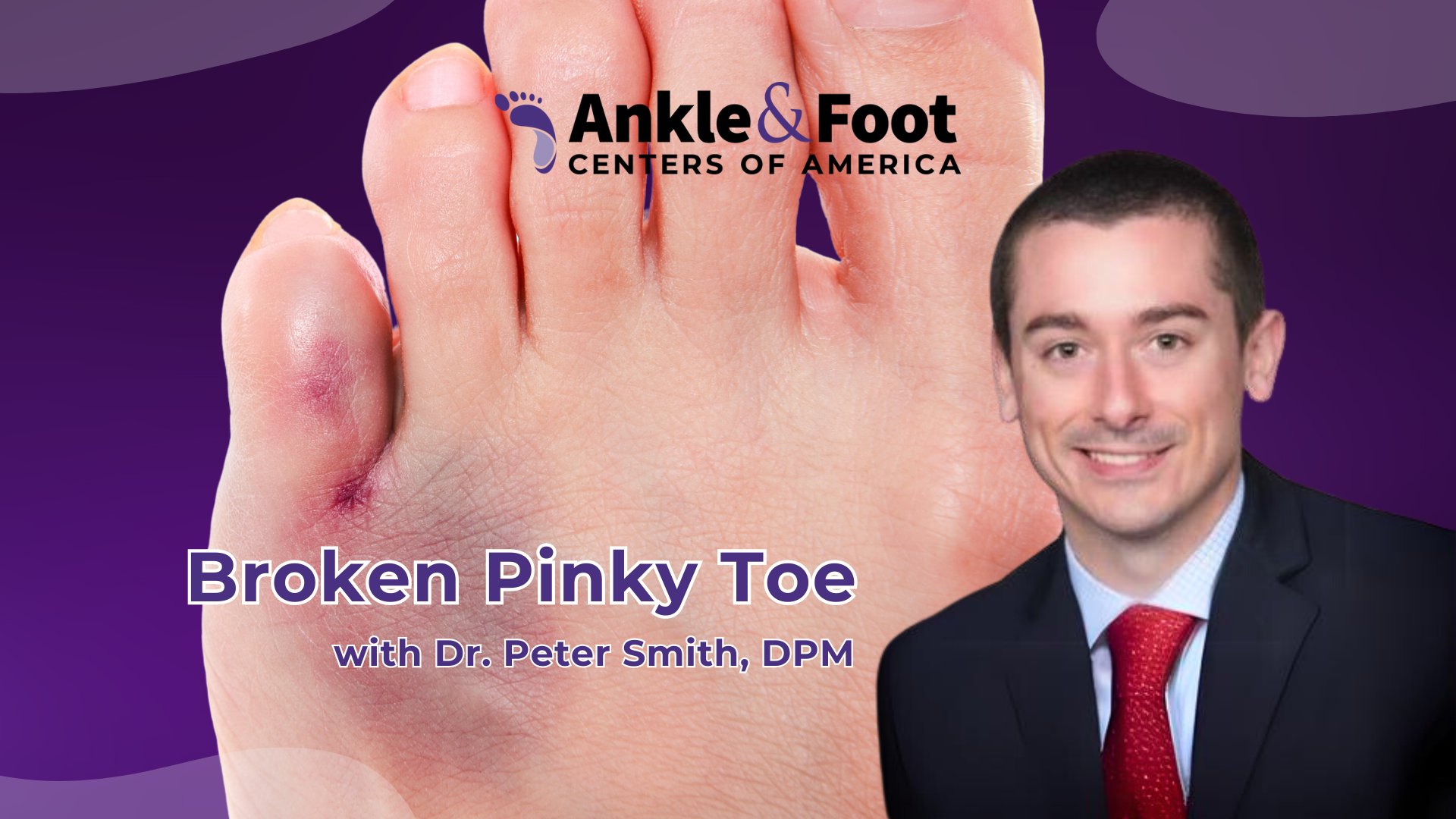Table of Contents
Understanding the Pinky Toe
The pinky toe, also known as the little toe or fifth toe, plays a significant role despite its small size. It comprises three phalanges connected by joints, ligaments, and tendons, contributing to the strength, mobility, and dexterity of the foot.
Function and Role in Balance
Balance is a delicate interplay of forces, and each part of the body plays a role in maintaining it. The pinky toe contributes significantly to balance by providing additional points of contact with the ground. When you walk or stand, the pinky toe shares the responsibility of supporting your body weight, helping you maintain stability and preventing falls.
Vulnerability to Injuries
Despite its crucial role in balance, the pinky toe is relatively exposed and vulnerable to injuries. Due to its position at the edge of the foot, it is more likely to come into contact with objects, be subjected to accidental trauma, or get jammed against furniture or door frames. This vulnerability makes the pinky toe prone to various injuries, including fractures, dislocations, and soft tissue damage.
Athletes, in particular, may be at a higher risk of injuring their pinky toes, especially in sports that involve quick directional changes, such as soccer or basketball. Additionally, improper footwear choices, like ill-fitting shoes or high heels, can contribute to pinky toe injuries by putting undue pressure on this small but vital digit.
 Causes of a Broken Pinky Toe
Causes of a Broken Pinky Toe
A broken pinky toe, also known as a pinky toe fracture, is a relatively common injury that can be both painful and inconvenient. Understanding the various causes of a broken pinky toe is essential for effective prevention and treatment of this injury.
Accidental Trauma
One of the most frequent causes of a broken pinky toe is accidental trauma. This can occur when the pinky toe comes into forceful contact with a hard object. Common scenarios include stubbing the toe against furniture, walls, or door frames. The impact can result in a fracture of one or more of the pinky toe’s phalanges (bones), causing immediate pain and swelling.
Sports-Related Injuries
Athletes and individuals who participate in sports that involve quick movements, changes in direction, or physical contact are at a heightened risk of sustaining pinky toe injuries. Sports like soccer, basketball, football, and martial arts often expose the feet to sudden and forceful impacts.
In these cases, a broken pinky toe can occur when an athlete collides with an opponent, the ground, or sports equipment, such as a soccer ball or basketball. The force of these impacts can lead to fractures in the pinky toe bones or dislocations of the toe joints.
Stubbing or Jamming
Stubbing or jamming the pinky toe is a common cause of fractures. This can happen when an individual accidentally kicks an object or jams their toe into a solid surface while walking or running. The abrupt and forceful stoppage can result in damage to the bones, ligaments, or tendons in the pinky toe.
Even seemingly minor incidents, such as catching the toe on a raised edge or stepping on an uneven surface, can lead to a broken pinky toe if the force is sufficient. It’s important to note that the severity of the injury may not always be immediately apparent, and symptoms may develop over time.
Footwear Issues
The choice of footwear can also contribute to pinky toe injuries. Ill-fitting shoes, particularly those with narrow or cramped toe boxes, can exert pressure on the pinky toe, causing discomfort or chronic stress. Over time, this pressure can lead to stress fractures or soft tissue injuries in the pinky toe.
High-heeled shoes, in particular, can alter the distribution of weight across the foot, placing excessive pressure on the front of the foot, including the pinky toe. Prolonged wear of high heels can lead to chronic conditions, such as “pump bump” (Haglund’s deformity) or “hammertoe,” which can predispose the pinky toe to fractures.
Recognizing the Signs of a Broken Pinky Toe
When it comes to identifying a broken pinky toe, recognizing the signs and seeking proper medical evaluation are critical steps in the healing process. To shed light on this topic, we turn to the expertise of Dr. Peter Smith, a renowned Doctor of Podiatric Medicine.
According to Dr. Peter Smith, a broken pinky toe can manifest a range of symptoms, some of which may be subtle while others are more pronounced. It’s important to pay attention to these signs, as early diagnosis and treatment can significantly impact the healing process.
- Pain: Pain is often the most immediate and noticeable symptom. Dr. Smith emphasizes that a broken pinky toe can cause intense pain at the site of the injury. This pain may be sharp, throbbing, or achy, and it can worsen when attempting to move the toe or put weight on it.
- Swelling: Swelling around the pinky toe is another common indicator. Dr. Smith notes that the injured area may appear swollen, tender to the touch, and possibly discolored due to bruising.
- Limited Range of Motion: In some cases, a broken pinky toe may limit the range of motion of the toe. Dr. Smith explains that you may find it challenging to move the toe or bear weight on it, particularly if the fracture is severe or if there is a dislocation.
- Deformity: In more severe fractures or dislocations, a visible deformity of the pinky toe may be apparent. Dr. Smith emphasizes that if the toe appears misaligned or dislocated, it’s essential to seek medical attention promptly.
- Difficulty Walking: As the pinky toe plays a role in balance, a broken pinky toe can make walking and maintaining stability difficult. Dr. Smith advises that limping or altered gait patterns may be observed in individuals with a fractured pinky toe.
Seeking Medical Advice
 Dr. Peter Smith, stresses the importance of consulting a medical professional if you suspect you have a broken pinky toe. While some minor fractures may heal on their own with proper care, others may require more advanced treatment to ensure proper alignment and prevent long-term complications.
Dr. Peter Smith, stresses the importance of consulting a medical professional if you suspect you have a broken pinky toe. While some minor fractures may heal on their own with proper care, others may require more advanced treatment to ensure proper alignment and prevent long-term complications.
In cases where the symptoms are severe, if there is visible deformity, or if you have underlying medical conditions that affect bone health, seeking prompt medical attention is crucial. A podiatrist like Dr. Smith is trained to diagnose and treat foot and toe injuries effectively.
Complications and Warning Signs
- Visible Deformity: If your pinky toe appears misaligned, dislocated, or deformed, it’s a clear indication that you should seek immediate medical attention. A visible deformity may indicate a more severe fracture or dislocation, necessitating professional evaluation and intervention.
- Persistent Severe Pain: While pain is expected with a broken pinky toe, if the pain is severe and persists, it may indicate a more complex injury. Dr. Smith advises not to dismiss severe pain, as it could be a sign of a displaced fracture or associated damage to ligaments or tendons.
- Inability to Move or Bear Weight: If you find it extremely challenging or impossible to move your pinky toe or put any weight on it, this may signify a significant fracture or dislocation. Seeking medical help promptly is essential to assess the extent of the injury.
- Open Wound or Bleeding: In cases where the skin is broken, and there is an open wound or bleeding associated with the pinky toe injury, it should be examined by a healthcare professional to prevent infection and ensure proper wound care.
The Importance of a Medical Evaluation
 Dr. Smith underscores the significance of seeking professional medical evaluation for a broken pinky toe. While some minor fractures may heal with self-care, an accurate diagnosis is essential to rule out more severe injuries that may require specific treatments or interventions.
Dr. Smith underscores the significance of seeking professional medical evaluation for a broken pinky toe. While some minor fractures may heal with self-care, an accurate diagnosis is essential to rule out more severe injuries that may require specific treatments or interventions.
- X-ray Examination: A podiatrist or orthopedic specialist can conduct an X-ray examination to determine the precise location and severity of the fracture. X-rays help guide the treatment plan, whether it involves immobilization, casting, or, in rare cases, surgery.
- Assessment of Soft Tissues: A medical evaluation also includes an assessment of the surrounding soft tissues, such as ligaments and tendons. Damage to these structures may accompany a pinky toe fracture and require appropriate management.
- Treatment Planning: Once the extent of the injury is known, a healthcare professional can create an individualized treatment plan tailored to the specific needs of the patient. This plan may involve recommendations for immobilization, pain management, and rehabilitation.
Broken Pinky Toe Treatment: What You Need to Know
When faced with a broken pinky toe, also known as a broken little toe or pinky toe fracture, understanding the available treatment options is essential for a successful recovery. In this section, we’ll delve into the key aspects of broken pinky toe treatment, including insights from podiatric specialist Dr. Peter Smith.
Conservative Management
In most cases, a broken pinky toe can be effectively treated without surgical intervention. Dr. Smith emphasizes that conservative management is the primary approach, focusing on non-invasive methods to promote healing.
- Immobilization: Immobilizing the injured pinky toe is crucial. This can be achieved through various means, such as buddy taping (taping the pinky toe to the adjacent toe for support), using a splint, or wearing a specialized medical shoe. Immobilization helps stabilize the fracture site and prevents further injury.
- Rest: Rest is essential for allowing the fractured pinky toe to heal. Minimizing weight-bearing activities, avoiding strenuous exercise, and refraining from activities that could exacerbate the injury are key aspects of restful recovery.
- Elevation: Elevating the injured foot above heart level can help reduce swelling and alleviate discomfort. Dr. Smith recommends keeping the foot elevated, especially during the initial days after the injury.
- Pain Management: Over-the-counter pain relievers, as directed by your healthcare provider, can help manage pain and reduce inflammation during the healing process.
Surgical Intervention (Rare Cases)
 While surgical intervention is rarely necessary for a broken pinky toe, it may be considered in certain situations. Dr. Smith explains that surgical treatment is typically reserved for complex fractures or dislocations that cannot be adequately managed with conservative methods.
While surgical intervention is rarely necessary for a broken pinky toe, it may be considered in certain situations. Dr. Smith explains that surgical treatment is typically reserved for complex fractures or dislocations that cannot be adequately managed with conservative methods.
- Open Reduction: In cases where the pinky toe fracture is severely displaced or involves multiple fractures, surgical intervention may involve an open reduction. This procedure involves repositioning the fractured bones and securing them with pins, screws, or plates.
- Closed Reduction: For less severe fractures, a closed reduction may be performed. In this minimally invasive procedure, the healthcare provider manipulates the fractured bones back into their proper alignment without making incisions. The toe is then immobilized to allow for healing.
Rehabilitation and Follow-Up
Rehabilitation plays a crucial role in restoring the strength and function of the pinky toe and adjacent structures. Dr. Peter Smith advises patients to follow these steps:
- Gradual Return to Activity: As the pinky toe heals, gradually reintroduce weight-bearing activities and exercises to regain strength and mobility. Physical therapy may be recommended to aid in this process.
- Follow-Up Appointments: Regular follow-up appointments with a healthcare provider are essential to monitor the healing progress, adjust the treatment plan as needed, and address any concerns or complications that may arise.

Frequently Asked Questions (FAQ)
Q: How to Tell If My Pinky Toe Is Broken?
A: Recognizing a broken pinky toe involves paying attention to signs such as immediate pain upon impact, swelling, bruising, and potential misalignment. Difficulty moving the toe and increased pain during movement are also indicators. If in doubt, it’s advisable to consult a healthcare professional for a thorough assessment, possibly including X-rays.
Q: What Does a Broken Pinky Toe Look Like?
A: A broken pinky toe may appear swollen, bruised, and exhibit changes in shape or alignment. In some cases, the toe may take on a visibly different position than usual. The severity of the fracture can vary, and visual cues, along with pain and discomfort, are key factors in identifying a broken pinky toe.
Q: How Long Does a Broken Pinky Toe Take to Heal?
A: The healing time for a broken pinky toe varies based on factors such as the severity of the fracture and the chosen treatment. Generally, mild fractures may take a few weeks to heal, while more severe fractures may require a more extended recovery period. Compliance with treatment plans, rest, and professional guidance contribute to a smoother healing process.
Q: How to Treat a Broken Pinky Toe?
A: Treatment for a broken pinky toe often involves rest and immobilization, ice and elevation for pain management, over-the-counter pain relievers, and in some cases, medical interventions. Seeking prompt professional help, such as consulting a podiatrist like Dr. Peter Smith, ensures an accurate diagnosis and appropriate treatment plan tailored to the individual’s needs.
Q: Can You Leave a Broken Pinky Toe Untreated?
A: While some minor fractures may heal on their own with proper care, leaving a broken pinky toe untreated can lead to complications. Untreated fractures may result in persistent pain, deformities, and difficulties in movement. It’s advisable to seek medical attention to ensure a proper diagnosis and receive guidance on the most suitable treatment options for optimal recovery.
About the Author: Dr. Peter Smith, DPM
Dr. Peter Smith is a highly regarded podiatrist with a wealth of knowledge and experience in the field of podiatric medicine. He earned his doctorate in podiatric medicine from the prestigious Temple University School of Podiatric Medicine in Philadelphia, Pennsylvania. Dr. Smith’s commitment to excellence in his education laid the foundation for a successful career dedicated to foot health and care.
Following his doctoral studies, Dr. Smith pursued a comprehensive 3-year Podiatric Surgical Residency with a focus on Rearfoot and Ankle at Reading Hospital. This intensive training equipped him with specialized skills in addressing a wide range of foot and ankle conditions, including fractures, deformities, and surgical interventions. His residency provided invaluable hands-on experience, allowing him to refine his expertise and stay at the forefront of advancements in podiatric care.
Dr. Smith’s dedication to continuous learning and staying abreast of the latest developments in his field is evident in his Board Certification. Having successfully met the rigorous standards set by the relevant professional board, Dr. Smith has demonstrated his commitment to maintaining the highest levels of competence and proficiency in podiatric medicine.
Take Your First Step Towards Better Foot Health Today!
 If you suspect you have a broken pinky toe or have any concerns about your foot health, don’t wait. Schedule a consultation with a qualified podiatrist like Dr. Peter Smith, who can provide expert diagnosis and personalized treatment options. Your feet deserve the best care, and seeking professional help is the first step toward a pain-free and active lifestyle.
If you suspect you have a broken pinky toe or have any concerns about your foot health, don’t wait. Schedule a consultation with a qualified podiatrist like Dr. Peter Smith, who can provide expert diagnosis and personalized treatment options. Your feet deserve the best care, and seeking professional help is the first step toward a pain-free and active lifestyle.





